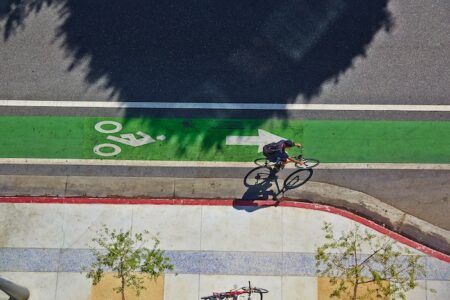A study by one of Europe’s leading lot managers, Apcoa Parking, in 2013, showed that drivers in German city centers may need an average of 10 minutes and will cover three miles (4.5km) to find a vacant parking spot. With drivers searching for parking space accounting for an estimated 30% of traffic in European inner cities, Siemens AG has developed a radar system that tells drivers, via their smartphone, where to look for a free spot. Starting in April, the company plans a testing program in Berlin, using about 40 radar sensors mounted on street lamps. Each detector, about half a shoebox in size, scans 30m (100 feet) of road and uses a smartphone application to transmit information about potential spaces matching the car’s size.
Currently piloting in Munich, the complete system uses a sensor network, based on the newly developed radar units mounted overhead (pictured), which continuously monitor the parking facility and reports the occupancy status to a parking control center. Because the sensors are easy to install on or in street lights, there is no need for major work on the infrastructure. The system is also more accurate than an in-pavement sensor, and not only notifies if there is an object in the parking space, but also sends information about the size and position of the vehicle. The overhead system also detects any obstructions on cycle paths, bus lanes or garage and forecourt entrances caused by incorrectly parked vehicles. The measurement data is transmitted via the 3G cell phone network to the control center, which records the sensor data, calculates the corresponding parking space occupancy, and prepares it for use by parking facility operators and for drivers to locate available parking spaces.
The system is unusual in that the software system is capable of learning. It detects recurring parking space situations at particular times and calculates forecasts, so that users know what to expect when they arrive at their destination. Siemens uses technology from the USA-based Intel Corporation for connecting the sensors to the internet. Intel’s Internet of Things (IoT) platform enables the parking sensors to be connected securely and flexibly with the control center. The two companies believe the system is laying the foundations for a sensor and communication network that can be used in future Smart City concepts. “We’re in talks with several cities about their parking situation and about running pilot schemes,” said Marcus Zwick, head of the project at Siemens. “We expect to launch a pilot in Dubai this year, after Berlin. Radar mounted on street lamps or walls, and using existing power supplies, is easier to install and operate than underground equipment, which also needs to have batteries replaced periodically. Our radar system will be competitive with existing ground sensors.”




